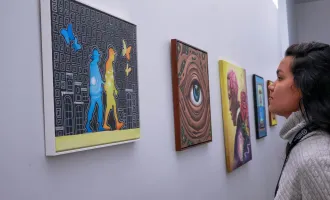
Singular Talent
Actor and singer Franc D’Ambrosio has performed as the lead in The Phantom of the Opera thousands of times, for millions of people. And he’s achieved this momentous fame without the ability to read music. D’Ambrosio has dyslexia. He remembers his first experiences struggling to read chords.
“I couldn’t see where the dots were. I couldn’t follow the line,” he said. The San Francisco Conservatory of Music honored musicians with dyslexia during “The Other Side of the Brain: Exploring Emotion and Music in Dyslexia,” an event on Feb. 4 in Hayes Valley.
In collaboration with the UCSF Memory and Aging Center, the Global Brain Health Institute, and the UCSF Dyslexia Center, the Conservatory hosted presentations on dyslexia research and performances by D’Ambrosio.
Additional performances were written by composer Winfield Carson, a Conservatory student with dyslexia, and Beethoven, who is thought to have had dyslexia.
One thousand ciphers
Professor Marilu Tempini, co-director of the UCSF Dyslexia Center, explained the concept of dyslexia to the audience.
Developmental dyslexia is a condition that causes people to have great difficulty with reading and spelling. Individuals with dyslexia have normal IQ scores but may struggle to process language.
Tempini stressed the importance of identifying dyslexia early so that teaching can be tailored to student needs. Without early identification, those with the condition have a heightened risk of anxiety, depression, and dropping out of school.
Languages like English are actually more difficult for the dyslexic brain than those like Italian with more straightforward spelling systems.
Dyslexia researchers estimate that the 40 sounds of spoken English are represented by over 1,000 spellings. Deciphering these 1,000 spellings is not easy for anyone at the early stages of learning the language, but eventually a fluency becomes established. Not so for those with dyslexia, for whom the task remains difficult throughout their lifetime.
Tempini presented ongoing research which suggests dyslexic patients have different patterns of brain connectivity between areas responsible for speech, reading, and emotion.
The other side of dyslexia
It’s not all negative, however. Dyslexia, with its altered patterns of brain connectivity, may also give individuals unique strengths.
Professor Virginia Sturm, director of the Clinical Affective Neuroscience Laboratory at UCSF, told the audience about her study showing that dyslexic children experience enhanced emotions.
While watching video clips, dyslexic children showed stronger facial expressions as well as greater changes in heart rate and breathing.
Sturm said that this kind of emotional attunement might lead to more emotional musical performance and composition in dyslexic people who pursue music.
Tempini said that musical talent in those with dyslexia may be masked at first, and that it’s important to find other strategies for teaching music in addition to reading and writing.
Dr. Anne Browning, Atlantic Fellow for Equity in Brain Health at the Global Brain Health Initiative, recalled hiding her reading difficulties for many years.
“And then Hamlet happened,” she said.
In her 12th grade class, she fumbled while trying to sound out the words of Shakespearean English.
“I had no idea what I was saying,” she said.
Luckily, the incident led to a diagnosis and a greater understanding of her condition, as well as personal growth.
Browning said her reading difficulties taught her compassion for herself and for others, as well as resilience in the face of adversity.
“And that has proven to be a superpower,” she said.
Another advantage among dyslexic people, according to a recent article in Scientific American, may be more able to “see the big picture” both in terms of vision and in sound.
Additionally, individuals with dyslexia develop various strengths simply by navigating life successfully with a learning disability, as D’Ambrosio exemplifies.
He said he is still devising new ways to learn music, and has worked for many years to learn and sing in Italian. His work in Italy with Italian song and culture recently prompted the Italian president to bestow a knighthood upon him.
Watch a recording of “The Other Side of the Brain: Exploring Emotion and Music in Dyslexia,” here.



